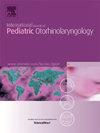Associations between retinopathy of prematurity and the risks of hearing loss: A propensity matched analysis
IF 1.2
4区 医学
Q3 OTORHINOLARYNGOLOGY
International journal of pediatric otorhinolaryngology
Pub Date : 2025-03-26
DOI:10.1016/j.ijporl.2025.112322
引用次数: 0
Abstract
Purpose
While retinopathy of prematurity (ROP) and hearing loss (HL) share many risk factors, whether patients with ROP have a higher risk of HL remains largely unknown. Therefore, this study aimed to explore the association between ROP and the risk of having HL.
Methods
The electronic medical records contained in a United States national database were retrospectively reviewed. Patients younger than 18 years old with a record of receiving hearing screening were included. Eligible patients with a history of ROP were assigned to the ROP cohort, while those without ROP diagnosis after vision screening served as controls. After adjusting for covariates via propensity score matching, the two cohorts were compared to evaluate the odds ratios (OR) of having hearing loss. To assess the impact of ROP severity and treatment on the OR, secondary analyses were additionally performed by further stratifying the ROP cohort based on the severity and treatment status.
Results
The primary analysis revealed that, compared to controls (n = 2,978, mean age: 2.34 ± 2.77 years; 51.1 % female) the ROP cohort (n = 2,978, mean age: 2.40 ± 3.13 years; 50.9 % female) had higher odds of having HL (OR = 1.42, CI = 1.25–1.61). However, among patients with ROP, the odds of HL did not differ between the mild and severe cohorts (OR = 0.99, CI = 0.73–1.34) or between the treated and untreated cohorts (OR = 0.79, CI = 0.50–1.24).
Conclusion
HL was more common among children with ROP after adjusting for other risk factors of HL. Confirmation of this association in future controlled research settings could provide a rationale for increasing the frequency of hearing screening in children with ROP.
早产儿视网膜病变与听力损失风险之间的关系:倾向匹配分析
虽然早产儿视网膜病变(ROP)和听力损失(HL)有许多共同的危险因素,但早产儿视网膜病变(ROP)患者是否有更高的HL风险仍不得而知。因此,本研究旨在探讨ROP与HL风险之间的关系。方法回顾性分析美国国家数据库中的电子病历。年龄小于18岁且有听力筛查记录的患者被纳入研究对象。有ROP病史的符合条件的患者被分配到ROP队列,而视力筛查后未诊断为ROP的患者作为对照组。在通过倾向评分匹配调整协变量后,比较两个队列以评估听力损失的优势比(OR)。为了评估ROP严重程度和治疗对OR的影响,我们根据严重程度和治疗状况对ROP队列进行进一步分层,进一步进行了二次分析。结果初步分析显示,与对照组(n = 2978)相比,患者平均年龄:2.34±2.77岁;51.1%为女性)ROP队列(n = 2978,平均年龄:2.40±3.13岁;50.9%的女性)患HL的几率更高(OR = 1.42, CI = 1.25-1.61)。然而,在ROP患者中,轻度和重度队列(OR = 0.99, CI = 0.73-1.34)或治疗组和未治疗组(OR = 0.79, CI = 0.50-1.24)之间HL的发生率没有差异。结论在校正HL的其他危险因素后,HL在ROP患儿中更为常见。在未来的对照研究中证实这种关联可以为增加ROP儿童听力筛查的频率提供依据。
本文章由计算机程序翻译,如有差异,请以英文原文为准。
求助全文
约1分钟内获得全文
求助全文
来源期刊
CiteScore
3.20
自引率
6.70%
发文量
276
审稿时长
62 days
期刊介绍:
The purpose of the International Journal of Pediatric Otorhinolaryngology is to concentrate and disseminate information concerning prevention, cure and care of otorhinolaryngological disorders in infants and children due to developmental, degenerative, infectious, neoplastic, traumatic, social, psychiatric and economic causes. The Journal provides a medium for clinical and basic contributions in all of the areas of pediatric otorhinolaryngology. This includes medical and surgical otology, bronchoesophagology, laryngology, rhinology, diseases of the head and neck, and disorders of communication, including voice, speech and language disorders.

 求助内容:
求助内容: 应助结果提醒方式:
应助结果提醒方式:


